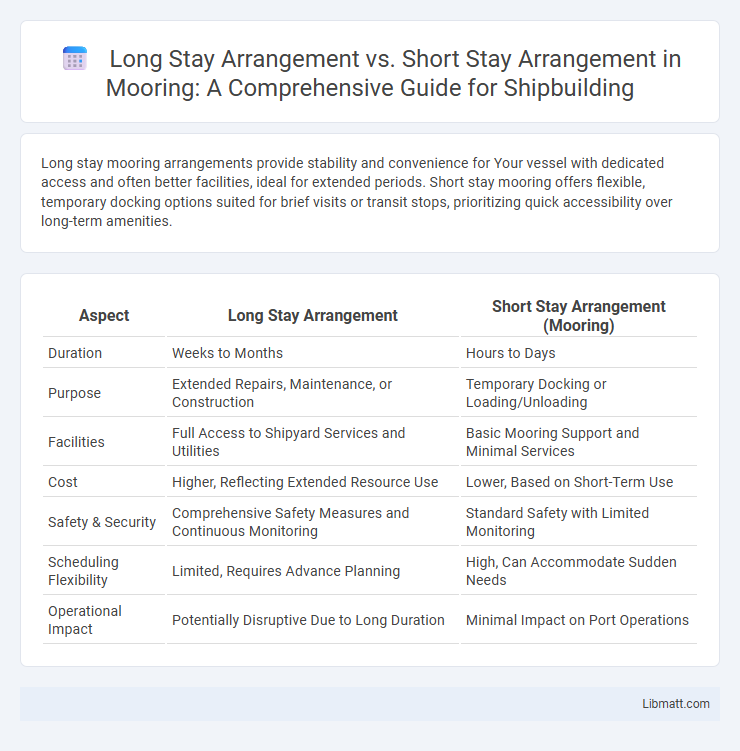Long stay mooring arrangements provide stability and convenience for Your vessel with dedicated access and often better facilities, ideal for extended periods. Short stay mooring offers flexible, temporary docking options suited for brief visits or transit stops, prioritizing quick accessibility over long-term amenities.
Table of Comparison
| Aspect | Long Stay Arrangement | Short Stay Arrangement (Mooring) |
|---|---|---|
| Duration | Weeks to Months | Hours to Days |
| Purpose | Extended Repairs, Maintenance, or Construction | Temporary Docking or Loading/Unloading |
| Facilities | Full Access to Shipyard Services and Utilities | Basic Mooring Support and Minimal Services |
| Cost | Higher, Reflecting Extended Resource Use | Lower, Based on Short-Term Use |
| Safety & Security | Comprehensive Safety Measures and Continuous Monitoring | Standard Safety with Limited Monitoring |
| Scheduling Flexibility | Limited, Requires Advance Planning | High, Can Accommodate Sudden Needs |
| Operational Impact | Potentially Disruptive Due to Long Duration | Minimal Impact on Port Operations |
Overview of Mooring Arrangements
Mooring arrangements define how vessels are secured at a port or marina, with long stay arrangements typically involving extended docking periods, often benefiting from fixed mooring spots and reduced daily rates. Short stay arrangements prioritize flexibility for transient visits, allowing swift access to mooring spaces with higher fees but minimal commitments. Your choice depends on the vessel's usage frequency and duration, balancing cost-efficiency and convenience within these mooring frameworks.
Definition: Long Stay Arrangements
Long stay arrangements refer to mooring agreements where vessels remain docked for extended periods, typically beyond 30 days, often involving residential or seasonal use. These agreements provide consistent access to marina facilities, utilities, and security services tailored to accommodate prolonged occupancy. Understanding long stay arrangements helps you plan mooring strategies that optimize cost-effectiveness and convenience for extended vessel accommodation.
Definition: Short Stay Arrangements
Short stay arrangements refer to temporary mooring solutions designed for brief periods, typically ranging from a few hours up to several days. These are ideal for travelers who require quick access to docks, marina facilities, or coastal amenities without the commitment of long-term leases. You benefit from flexibility and convenience when opting for short stay mooring arrangements.
Key Differences Between Long and Short Stay Moorings
Long stay mooring arrangements typically involve extended periods, often several months or more, providing stable, dedicated berths ideal for full-time boaters or liveaboards. Short stay moorings cater to temporary stays ranging from a few hours to days, designed for transient visitors requiring flexible access and quicker turnaround. Key differences include cost structures, reservation policies, and available amenities, with long stay moorings offering discounted rates and enhanced facilities compared to short stay options.
Advantages of Long Stay Mooring
Long stay mooring offers enhanced security and stability for vessels, reducing the risk of damage during adverse weather conditions. It provides cost efficiency by allowing boat owners to avoid frequent relocation fees and maintenance associated with short stay arrangements. This type of mooring also facilitates easier access to shore facilities, promoting convenience and comfort during extended periods.
Benefits of Short Stay Mooring
Short stay mooring offers greater flexibility for boat owners, allowing easy access to different locations without long-term commitments. It provides convenient opportunities for quick stops, resupply, and exploration, enhancing overall boating experience. The short stay arrangement also reduces costs associated with extended mooring fees and maintenance responsibilities.
Factors to Consider When Choosing Mooring Type
When choosing between long stay and short stay mooring arrangements, factors to consider include the duration of stay, cost efficiency, and permitting requirements specific to each mooring type. Long stay moorings often require more substantial contracts and offer stability suited for extended periods, while short stay moorings provide flexibility and easier access for transient visits. Vessel size, frequency of use, and proximity to shore facilities also impact the suitability of either arrangement for boat owners.
Cost Comparison: Long vs Short Stay Mooring
Long stay mooring typically offers lower daily rates compared to short stay arrangements, making it more cost-effective for extended periods. Short stay mooring tends to have higher fees due to its flexibility and proximity to prime locations, increasing overall expenses for brief visits. Your choice should weigh these cost differences against the duration and frequency of your boat docking needs.
Safety and Maintenance Implications
Long stay arrangements typically require more robust safety measures such as reinforced mooring lines and regular hull inspections to prevent damage from prolonged exposure to environmental stressors. Short stay mooring focuses on quick access and minimal maintenance with simpler setups, but may increase risks from sudden weather changes or frequent docking. You should consider that long-term mooring demands ongoing maintenance schedules to ensure vessel integrity, while short-term arrangements prioritize flexibility with less intensive upkeep.
Best Practices for Selecting Mooring Arrangements
Selecting the best mooring arrangement depends on the duration and environment of the stay, with long stay arrangements requiring more robust systems to withstand changing weather and tides. Short stay mooring prioritizes flexibility and ease of access, often utilizing simple buoy-based systems or temporary anchors for quick deployment. Your choice should factor in vessel size, local regulations, and environmental impact to ensure safety and compliance.
Long stay arrangement vs short stay arrangement (mooring) Infographic

 libmatt.com
libmatt.com